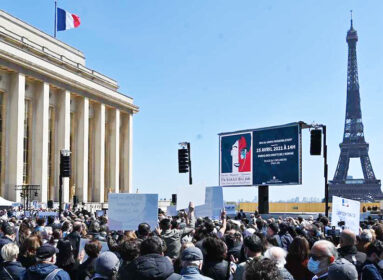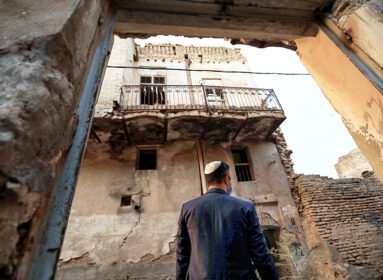Author discovering the lost town of Trochebrod
By Cindy Mindell
Once there was a Jewish town called Trochenbrod, hidden deep in the vast Radziwill forest of northwest Ukraine. From 1835, some 5,000 citizens – all Jews, but for a handful of gentile government appointees – farmed and ran small businesses, spoke Hebrew and maintained Jewish institutions, and attracted visitors from the surrounding Ukrainian and Polish villages.
By the mid-1940s, the once-bustling commercial center and its inhabitants had disappeared, with only a double row of towering street trees to mark where the main avenue once sprawled.
But there were memories and stories kept alive by descendants of those who had left the town for Palestine and America before its ultimate destruction. Author Jonathan Safran Foer, the grandson of Trochenbrod natives, brought the place to life in his 2002 novel, Everything Is Illuminated, adapted into a film in 2005.
By then, Avrom Bendavid-Val, another Trochenbrod descendant, had been researching the town and its history for nearly a decade. In 2012, he published The Heavens Are Empty: Discovering the Lost Town of Trochenbrod, with a preface by Foer. That same year saw the release of “Lost Town,” a documentary film chronicling Bendavid-Val’s investigations.
The film will be screened on Wednesday, July 30 at the Avon Theatre in Stamford, followed by a Q&A with Bendavid-Val.
The author spoke with the Ledger from his home in Washington, D.C. about bringing Trochenbrod back to life.
Q: What is your personal connection to Trochenbrod?
A: My father was born and raised there, and went to Palestine in 1932. He met my mother there and they came to the U.S. in 1939, first to New York and then to join my mother’s family in Washington, D.C. My grandfather had died in Trochenbrod at the time of World War I, so I never met him. My father, as I say in the book and the movie, never really talked about the town he’d come from. Whenever he did talk about, I could see in his facial expression a certain longing, a contemplative look that conveyed how very deep within him and important to him the place was. Like an idiot, I never asked him about it as a kid growing up in America. He passed away and I didn’t know anything about it. I started out just wanting to know about the town my father came from. A few relatives told me, “It’s not there anymore” and I couldn’t believe that.
I was working in Warsaw and realized that Trochenbrod was just across the border and that I could go there. The first time I visited the place, in 1997, it was very moving. I had thought it was a village and only after I began my research, I found out that it was no village but a town. I thought, “What is this – a town of 5,000 in the middle of the forest?” and I began getting swept up in the place, fascinated by the town and its unique and important story, well beyond my own father’s story.
As a regional and urban planner, I was interested in the town and how it related to surrounding villages; that was my professional specialty.
 Q: How was Trochenbrod different from other Eastern European Jewish shtetls?
Q: How was Trochenbrod different from other Eastern European Jewish shtetls?
A: Trochenbrod was very interesting because it was completely different from other shtetls; there was nothing like it in the whole world except in Palestine.
There are three principal ways that the town was totally different from other shtetls. First, it was agricultural: Jews in Eastern Europe did not engage in agriculture. In most cases, they were not allowed to own land, so to have a Jewish agricultural village was unheard of at the time. Almost all other shtetls were part of other towns; they were Jewish neighborhoods in gentile towns, like in “Fiddler on the Roof.” Even in the rural areas, the Jews were not the farmers but rather the people who serviced the farmers.
Trochenbrod started as an agricultural village and every house had a farm field behind it, and continued with agriculture even as the people took on trades of various kinds to service the surrounding villages and achieve some prosperity. At its height, it was home to 100 business establishments. A lot of people would go there to enjoy the country air – you were in the country, there was a big forest right nearby, and the air was full of the scent of pine. When my father’s brother moved away, he always went back to be with the family and to breathe the good country air.
The second way Trochenbrod was different was that it was a stand-alone all-Jewish town, not a shtetl that was part of another town or city. Between the World Wars, two or three non-Jews lived there, appointed by the government – like a postmistress and a constable and a guy who owned the state-run vodka store, which was given as a reward to Polish soldiers from the First World War. Ordinary citizens of the town were all Jewish, and there was also a satellite village, Lozist, which was very close and closely connected to Trochenbrod.
The third way the town was different was that it was isolated and hidden in the forest, connected to other villages by country trails. It got started as a way of escaping certain anti-Semitic czarist edicts, which people could do if they settled on unused land to farm. A few families from surrounding cities went to this low, swampy place and started to learn how to farm.
The town was partly destroyed during the German occupation during World War II, but then partisans burned everything they could because they didn’t want the Nazis or Ukrainians to use it, and then the Soviets plowed everything under. The Germans murdered everybody, but the town was destroyed by degrees.
Q: How did the documentary film come about and how were you involved in it?
A: I was in Israel in 2005 interviewing a group of natives and descendants who had settled in Tel Aviv and established the Beit Tal Trochenbrod-Lozist Landsmanschaft or affinity group. Some of them had known my father. At one point, we agreed that they would try to establish themselves as the international center for Trochenbrod people. I said I’d go back to the U.S. and draw up a list of people here. They dropped the ball and never did establish the center, but I started collecting names and addresses and the network spread like wildfire.
I suggested a get-together of Baltimore- and Washington-area descendants, and people around the country started hearing about it and wanted to come; 140 came from all over the country for a two-hour meeting. There used to be Landsmanschafts [affinity groups] all over the country, but they all stopped functioning after World War II; the whole network had dissolved, except in Israel. The event took place at what used to be the main synagogue in Washington, the Sixth and I Synagogue, and the director happens to be Esther Safran Foer.
I thought that we ought to do a movie, and said that if anybody knows anyone in the movie business, they should get in touch with me. Somebody did, and I was connected with Jeremy Goldscheider, a fourth-generation Trochenbrod descendant who had grown up in Baltimore and was living in L.A. and is a filmmaker, and we started working on the film. Jeremy and co-director Richard Goldgewicht started to make the film; I wanted it to be about Trochenbrod, and was willing to help in any way I could, but I’m not a filmmaker. They showed it to colleagues who said that it was boring, and that you can’t do a film about a town, but have to have a human story to make it work. So I became the human story in the film. I have tons of material and my story is related to Trochenbrod, so they built the film around the story of my research to bring Trochenbrod back to life.
The film is not about “one man’s obsessive search for his roots;” it’s the story of Trochenbrod told through my going there and bringing people there, focusing on the town between the World Wars and the Holocaust, and on the re-ingathering of its descendants. The film ends with the first international reunion of descendants held on the site in 2009, that I helped put together – Israelis, Americans, and one couple from Brazil, as well as a Jew living in Ukraine who had survived the war.
On the 2009 trip, we spent a couple of days on site. Half or more of the group was Israelis and they wanted nothing to do with the Ukrainians, whom they considered helpers of the Nazis. They wanted to say Kaddish at the mass gravesites and leave. There are two marked mass graves, and at least one or two smaller, unmarked ones. I arranged for horse-drawn wagons that were exactly like the ones their ancestors had used, to take them from the hotel to the site, and to give people the feeling of what life had been like there. They were driven by Ukrainians, who stood off to the side during the site visit. We had with us the son of the milkman who worked in Trochenbrod, and he told knew us who had lived in each house. We did a ceremony at a monument set up by the Israelis at the site of the town, and another ceremony at a monument at a mass grave in the forest.
In 2012, I took a group of Americans because they were very disappointed in the first trip; they wanted to get to know the Ukrainians and know what it had been like to interact with Trochenbrod. We invited the Israelis but they didn’t want to come. This time, we spent five days in the field. We visited surrounding villages where the old people, who had visited the town as children with their parents, told us stories and mentioned some families’ names and a couple of descendants of those families were on the trip.
We arranged a cultural exchange with the village to the east, which had been pro-Soviet during the war and the main source of partisans and had been close with Trochenbrod. Today, they’re different people, second and third and fourth generations, and they want to help resurrect the memorial of this town and help welcome the descendants of the town. I and others on that trip made a lot of good friends there.
They put on an incredible show of Ukrainian folklore – dancing, music, baking bread – and the Americans played guitar and sang Woody Guthrie songs and we did the Hora all together. It was very moving, like we were in another era. It was kind of a recognition that the way to overcome the past is to learn about each other and not avoid each other.
Q: How did you find your interview subjects?
A: During my research, I made three trips to the site and would immediately start talking to people. I’m used to functioning that way when I work in foreign countries – go into a new place, get to know the people, and learn all about the culture. Word would get around and in no time, I had this rich array of Ukrainian and Polish people who knew about Trochenbrod and remembered it and could tell me about their experiences there as young children. The research comes to me: people bring me artifacts and tell me stories they heard from their parents and grandparents.
On my third trip, I went to Yaromel, a nearby village, and saw an old lady sitting in front of a house. I asked her if she knew Trochenbrod and she said, “I’ve been waiting 50 years to talk about it.” Before that conversation, there would have been nobody to remember her or her stories after she dies. Now, as part of this project, she has a permanent existence.
Lost Town and Q&A with The Heavens Are Empty author Avrom Bendavid-Val: Wednesday, July 30, 7:30 p.m., Avon Theatre, 272 Bedford St., Stamford| Info/tickets: avontheatre.org, (203) 967-3660.
Comments? email cindym@jewishledger.com.








 Southern New England Jewish Ledger
Southern New England Jewish Ledger










